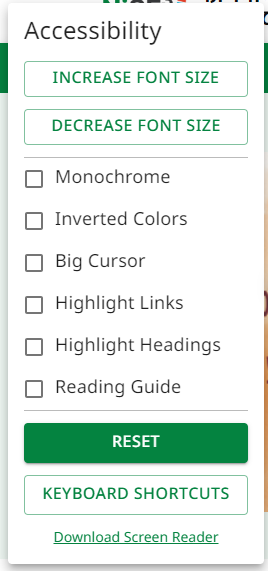 Accessibility ToolKit
Promoting accessibility as a cornerstone for inclusive digital development in Bangladesh.
Accessibility ToolKit
Promoting accessibility as a cornerstone for inclusive digital development in Bangladesh.

Challenges
The era of Digital Bangladesh is marked by a steadfast commitment to inclusivity, aiming to create a digital environment accessible to all. This journey began with recognizing the hurdles faced by persons with disabilities in accessing digital services. The lack of inclusive design and consideration for diverse needs led to several significant challenges:
- Limited Text Size Options: Websites and applications often came with limited options for text size adjustment, making it difficult for individuals with visual impairments to read or comprehend information.
- Inadequate Color Contrast: The color contrast on many digital platforms was inadequate, posing challenges for people with visual impairments or color blindness in differentiating text from its background, which affected readability.
- Small Cursors: The small default cursor size on digital interfaces made navigation and interaction cumbersome for individuals with motor impairments or those facing precision challenges.
- Unmarked Hyperlinks: Hyperlinks were not always clearly marked or highlighted, complicating navigation for people with visual or cognitive impairments.
- Limited Headings and Structure: A lack of proper headings and structured layouts in websites made it difficult for users of screen readers to understand the organization of information on a page.
- Lack of Reading Guides: Without reading guides, individuals with cognitive impairments or learning disabilities found it challenging to maintain focus and track their reading progress.
- Incompatibility with Screen Reading Software: Many digital platforms were incompatible with screen reading software, hindering access to information for individuals with visual impairments.
Towards a Solution
In addressing these challenges, the development of the accessibility toolkit became a priority. The initiative, led by a2i, involved extensive consultation with persons with disabilities to ensure the toolkit would meet their needs effectively. More than 25 organizations of persons with disabilities (OPDs) and 150 individuals contributed to the toolkit's formation, ensuring a comprehensive approach to digital accessibility.
The toolkit introduced features designed to overcome the previously mentioned challenges, including options for text size adjustment, color transformation, enlarged cursors, highlighted hyperlinks, structured headings, reading guides, and compatibility with screen reading software. These features have been instrumental in making digital platforms more accessible to individuals with disabilities.
The success of the accessibility toolkit is evident in its adoption across various flagship initiatives of Digital Bangladesh. The National Portal, which houses 33,000 websites, has integrated these tools to ensure equal participation for individuals with disabilities. Similarly, MyGov, a platform offering 1,720 government services, and the NISE Portal, which focuses on skill development and employment, featuring over 2,000 companies and 4,313+ job opportunities, have been redesigned with inclusivity in mind. Finally, the national e-learning platform, Muktopaath, now offers over 200 courses tailored for accessibility, highlighting the commitment to creating an inclusive digital landscape.
Based on WCAG 2.1 principles, the toolkit provides comprehensive coverage of accessibility standards, applying to both public and private organizations in Bangladesh. This initiative not only promotes inclusivity in digital services and web design but also sets a benchmark for accessibility best practices in the region. To replicate this success elsewhere, a systematic approach involving needs assessment, localization of guidelines, stakeholder engagement, capacity building, and continuous improvement is recommended, alongside the engagement of beta testers or accessibility auditors to tailor solutions to specific disabilities and regional needs.
Contact Information
Countries involved
Supported by
Implementing Entities
Project Status
Project Period
URL of the practice
Primary SDG
Primary SDG Targets
Similar Solutions
| NAME OF SOLUTION | Countries | SDG | Project Status | |
|---|---|---|---|---|
360-Degree Awareness Tool to Fight COVID-19 Raising awareness and ensuring public wellbeing through a one-stop platform for fighting COVID-19 in Bangladesh |
Bangladesh | 16 - Peace and Justice Strong Institutions | Ongoing | View Details |
A-Card Initiative |
Bangladesh | 10 - Reduced Inequalities | Completed | View Details |
Accelerating Digital Transformation in All Ministries in Bangladesh Promoting the rapid design and implementation of plans to digitize all ministries and subordinate government institutions in Bangladesh |
Bangladesh | 10 - Reduced Inequalities | Ongoing | View Details |
Accelerator Labs Network Following collective intelligence methods to address emerging sustainability challenges and the growing demand for local solutions |
Bangladesh | 08 - Decent Work and Economic Growth 13 - Climate Action | Ongoing | View Details |
Accessibility of Financial Services and the Private Sector in Africa Maximizing the impact of financial cooperation on economic development and industrialization in Africa |
Bangladesh | 08 - Decent Work and Economic Growth | Completed | View Details |
